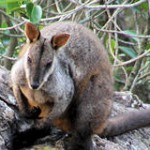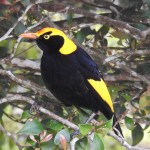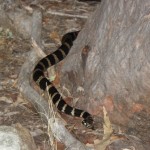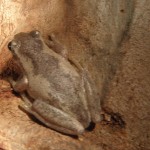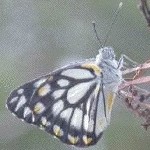Tips on identifying species
Notes by Ronda Green
Stay tuned! More information and advice will be here soon
Most of the books mentioned here will be available at major bookshops, the Qld Museum and in libraries
General
A couple of very useful general books on our local wildlife:
- Czechura, G. 2011. Wildlife of the Scenic Rim, Queensland Museum, Pocket Wild Guide
- Queensland Museum. Wildlife of Greater Brisbane Queensland Museum (packed with an amazing amount of in formation in a small volume, and very relevant to Scenic Rim as well as Brisbane)
Also visit iNaturalist for species that have so far been recorded in the Scenic Rim: this one is for Tamborine Mountain and this one of the entire Scenic Rim
You can also search the Atlas of Living Australia. This one is focussed on Mt Chinghee, but you can adjust it for your own region
Mammals
Mammals that are cat-sized or larger can usually be readily identified if seen clearly or good photographs are taken. Most of our mammals are nocturnal, which makes it more challenging, but with spotlights, binoculars, good telescopic lenses and motion-sensing cameras it’s certainly not impossible. Do make sure though that you don’t blind the animals by shining very bright lights directly into their eyes or taking flashlight photos from a close range.
Smaller mammals – with some exceptions – can be more difficult. Mouse-sized carnivorous marsupials, native and introduced rats and the many microbes species can be very difficult to identify without holding them or getting very good photos.
When viewing a mammal, try to see:
- whether it hops on two feet or runs with all 4 feet
- shape of face (e.g. long pointed snout?)
- relative size of ears, eyes and tail (e.g. the introduced black rat has a tail longer than its body, the native bush rat’s tail is a similar length to its body, and the native swamp rat has a slightly shorter tail and also smaller eyes and ears, greater gliders have very long tails and large fluffy ears, common brush tail possums have longer pointed ears than mountain brush tails and ringtails, etc.)
- Facial markings (especially wallabies – look for the exact pattern on the face, the back of the ears and the back of the neck, as there are some similarities between some species)
- Other features (e.g. the water rat has a white tail tip. Sugar gliders sometimes have white tail-tips but squirrel gliders never do. Quolls are the only spotted native mammals).
Some books that can assist are:
- Churchill, S. 1998. Australian Bats. New Holland Publishers Pty Ltd, Sydney, New South Wales.
- Hall, L. S. and Richards, G. C. 1979. Bats of Eastern Australia. Queensland Museum, Brisbane
- Strahan, R. and Van Dyck, S. (eds). 2008. The Mammals of Australia. New Holland Publishers Pty Ltd, Sydney, New South Wales.
- Taylor, J. M. 1984.The Oxford Guide to Mammals of Australia. Oxford University Press, Melbourne, Victoria.
- Triggs, B. 1996. Mammal Tracks and Signs: a field guide for south-eastern Australia. Oxford University Press, Melbourne, Victoria. [ very useful when the mammal itself isn’t present]
Facebook: Australian mammal identification
Birds
Birds are generally the easiest animals to identify. Most are active during the day, there are several good field books, and most have calls that can be identified from recordings. Some birds stay mostly high n the trees, others near the ground, some in thick vegetation and others in open areas. A few are nocturnal.
Always remember that:
- a species may have numerous calls, not all of which have been recorded
- many birds indulge in a bit of mimicry – not just lyrebirds (who are the real masters at it) but also magpies, bowerbirds, orioles and others
- don’t be too worried if you can’t find an exact match for the bird you’ve seen. Bird colours can vary somewhat geographically, and books don’t show every possibility. You may also see one that is partway between juvenile and adult plumage – a young. satin bowerbird that is green with haphazard patches of black, a young king parrot that is manly green with a few bits of red, etc.
- take note of distributions when identifying, You may well see something that only occasionally visits the Scenic Rim from neighbouring regions, but not a species that s confined to Tasmania or Cape Yorke Peninsula (although there could be occasional aviary escapes, especially parrots or finches)
- also see what it is doing, and read the notes in the bird guide. Although individual birds sometimes do things out of the ordinary, if flying high overhead it is highly unlikely to be a pheasant council or a lyrebird, and wompoo fruitdoves are very unlikely to feed on the ground or be seen in an open paddock. Some birds wag their tails left and right, others up an down. Yellow-throated and white-browed srubwrens usually forage in leaf litter while the large-billed scrubwren even in the same forest usually forages amongst the foliage of low shrubs. Etc.
- note the eye colour if possible. This can be a deciding factor with scrub wrens, thornbills and others.
- get a good photo if you can. This can really help with distinguishing between very similar species such as Bassian thrushes and russet-tailed thrushes (which are so similar they used to be considered the same species)
Some useful books include:
- Pizzey, G. and Knight, F. 1997. Field Guide to the Birds of Australia. Angus and Robertson, Sydney, New South Wales.
- Simpson, K. and Day, N. 1996. Field Guide to the Birds of Australia. Viking Publishers, Ringwood, Victoria.
- Slater, P., Slater, P. and Slater, R. 1989. The Slater Field Guide to Australian birds. Landsdowne Publishers, The Rocks, New South Wales.
- Morcombe, M. 2000. Field Guide to Australian Birds. Steve Parish Publishing Pty Ltd, Archerfield, Queensland.
Useful apps, which include calls as well as pictures and text, are:
- Pizzey and Knight Birds of Australia (GIBBON MULTIMEDIA AUS PTY LTD)
- The Morcombe & Stewart Guide to Birds of Australia (mydigitalearth.com)
Remember some birds have multiple calls, and a few can mimic each other
Facebook: Australian bird identification
Reptiles
Reptiles can be very variable in colour. (Brown snakes can be various shades of brown, and other snakes species can also be brown. Green tree snakes can be bush or almost black, etc.). Some venomous snakes can look very similar to harmless ones, so please don’t take any chances (and remember even non-venomous snakes such as carpet pythons can give a nasty bite, just as a cat or dog can do).
Some useful books:
- Cogger, H.G. 2000. Reptiles and Amphibians of Australia. Reed New Holland, Sydney, New South Wales.
- Patrick Couper, P. and Amey, A. Pocket Guide: Reptiles of Southeast Queensland. Queensland Museum
- Wilson, Steve. 2016. Reptiles of the Scenic Rim Region
- Cogger, H.G. 2000. Reptiles and Amphibians of Australia. Reed New Holland, Sydney, New South Wales.
Facebook: Australian Reptile/Amphibian Identification
Frogs
Frogs can also varying colour and (to a lesser extent) pattern. Eastern sedge frogs (small tree frogs often seen sitting on reeds and other foliage) may be bright green, brown, or a combination of green and brown,. All the frogs of our region (and there are about 40 of them) belong to two families – tree frogs and southern frogs, both sharing common. ancestors with South American frogs, from our Gondwana heritage. Note whether their feet are webbed, and whether they have pads for climbing, whether the nose is pointed, whether it leaps en erratically, and any other detail you can record as well as taking a clear photo if possible. Listening to and recording their calls is also very useful. Warm wet nights are usually the best time to find frogs.
Useuflbooks include:
- Cogger, H.G. 2000. Reptiles and Amphibians of Australia. Reed New Holland, Sydney, New South Wales.
- Czechura, G. A. Pocket Guide: Frogs of Southeast Queensland. Queensland Museum
Useful links:
Facebook: Australian Reptile/Amphibian Identification
Fish
You can identify many of the local fish from Queensland Museum. Wildlife of Greater Brisbane Queensland Museum
Insects
Remember all insects have 6 legs, at least as adults. A first step in identifying insects is to familiarise yourself with the various orders of insects: how can you tell if it is a bug (in the true sense) or a beetle? A moth or a caddis fly? A bee or a fly? The Zborowski and Storey book is a good start, and there area number of general insect books for both adults and children that explain the differences.
Some useful books:
- Chris Burwell. Pocket Guide: Ants of Southeast Queensland. Queensland Museum
- Braby, M.F. 2000. The Butterflies of Australia: their identification, biology and distribution. CSIRO Publishing, Melbourne, Victoria.
- Brock,P. D. and Hasenpusch, J. W. 2009. The Complete Field Guide to Stick and Leaf Insects of Australia. CSIRO Publishing, Melbourne, Victoria.
- Common, I.F.B. 1990. Moths of Australia. Melbourne University Press, Melbourne, Victoria.
- Common, I.F.B. and Waterhouse, D.F. 1981. Butterflies of Australia. Angus and Robertson, London, UK.
- CSIRO. 1991. The Insects of Australia: A textbook for students and research workers. Volume I & II. Cornell University Press, New York, USA. [warning: very comprehensive but also very expensive and not easy for the amateur]
- Fisher, R.H. 1995. A Field Guide to Australian Butterflies. Surrey Beatty & Sons, Chipping Norton, New South Wales.
- Hangay, G. and Zborowski, P. A Guide to the Beetles of Australia. CSIRO, Collingwood, Victoria.
- Orr, A. and Kitching, R. 2010. The Butterflies of Australia. Allen and Unwin
- Queensland Museum. Wildlife of Greater Brisbane Queensland Museum
- Rentz, D. A. 2010. A Guide to the Katydids of Australia. CSIRO, Collingwood, Victoria.
- Shattuck, S.O. 1999. Australian ants: their biology and identification. CSIRO, Collingwood, Victoria.
- Watson, J.A.L. 1991. The Australian Dragonflies: a guide to the identification, distributions and habitats of Australian Odonata. CSIRO, Canberra, Australian Capital Territory.
- Zborowski, P. and Storey, R. 2010. A Field Guide to Insects of Australia Reed Books, CSIRO, Collingwood, Victoria
Usefullinks:
Facebook: Amateur Entomology Australia
Spiders
Do you know no one has died of spider bite in Australia for almost three decades, and that most spiders are totally harmless to humans? There are many weird, wonderful and beautiful spiders living around us.
- Queensland Museum. Wildlife of Greater Brisbane Queensland Museum
- Raven, R. J., Harvey, M. S. and Behr, B. C. Spiders of Australia CD-Rom: Interactive Identification to Subfamily. CSIRO Publishing / Australian Biological Resources Study (ABRS)
- Raven, R. and Seeman, O. Pocket Guide: Spiders of the Greater Brisbane region. Queensland Museum
- Whyte, R. and Anderson, G. A Field Guide to Spiders of Australia. CSIRO
Useful links:
Crustaceans
- Jones, D. and Morgan, G. 1994. A field guide to Crustaceans of Australian Waters. Reed Books, Chatswood, New South Wales.
- McCormack, R. B. A guide to Australia’s Spiny Freshwater Crayfish
- Queensland Museum. Wildlife of Greater Brisbane Queensland Museum
- Williams, W.D. 1980. Australian Freshwater Life: The invertebrates of Australian inland waters. The Macmillan Company of Australia Pty Ltd, Melbourne, Victoria.
Other arthropods (centipedes, scorpions etc.)
- Harvey, M. S. and Yen, A. L. 1989. Worms to wasps : an illustrated guide to Australia’s terrestrial invertebrates
- Queensland Museum. Wildlife of Greater Brisbane Queensland Museum
Molluscs
-
-
- Harvey, M. S. and Yen, A. L. 1989. Worms to wasps : an illustrated guide to Australia’s terrestrial invertebrates
- Queensland Museum. Wildlife of Greater Brisbane Queensland Museum
-
Worms
- Harvey, M. S. and Yen, A. L. 1989. Worms to wasps : an illustrated guide to Australia’s terrestrial invertebrates
- Queensland Museum. Wildlife of Greater Brisbane Queensland Museum
Plants (general)
Leiper, Glazebrook, Cox and Rathie. Mangroves to Mountains: a Field Guide to the Plants of southeast Queensland.
Facebook: Australian Indigenous Plant Identification
iNatutralist records of plants on Tamborine Mountain
Trees and shrubs
Gwen Harden, Bill McDonald & John Williams. Rainforest Trees and Shrubs: a Field Guide to their Identification. Gwen Harden Publishing. [the most comprehensive guide to our local species]
Nicholson, N and Nicholson, H. Australian rainforest plants Volumes 1-6 Terania Rainforest Publishing [a very handy series if you’d like to also flick through colour photos instead of working through keys, but don’t expect to find every possible species: it can be used in combination with the keys in the book above]
App:
https://rainforests.net.au/product/rainforest-plants-of-australia-mobile-app/
Vines
Gwen Harden, Bill McDonald & John Williams.Rainforest Climbing Plants: a Field Guide to their Identification. Gwen Harden Publishing [the most comprehensive guide to our local species]
Monocotyledons (Orchids, lilies, grass trees, palms, grasses etc.)
Some useful links
Grasses of Southern Queensland
Facebook: South-East-Qld-Species-Orchid-society
https://queenslandorchid.wordpress.com/2013/08/12/native-orchids-of-australia/
Ferns
xx
Mosses and other liverworts (Bryophytes)
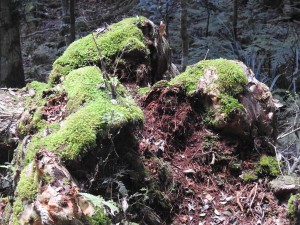 These represent some of the earliest land plants
These represent some of the earliest land plants
Some useful links:
https://www.anbg.gov.au/bryophyte/bryogeography-endemic-aust.html
https://www.anbg.gov.au/abrs/Mosses_online/
https://www.anbg.gov.au/bryophyte/classification-mosses.html
Fungi
xx
Back to main Bioblitz page





